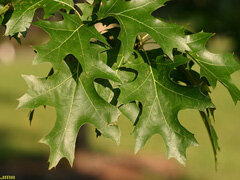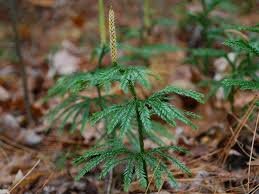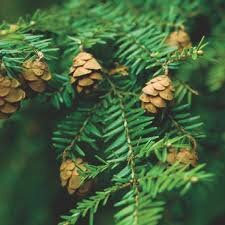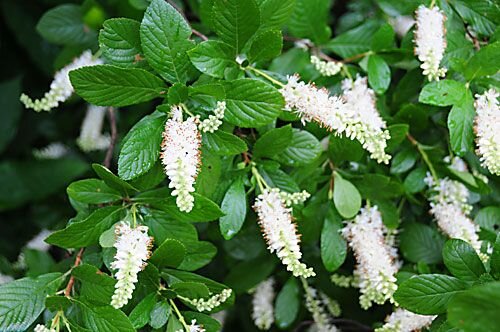Woodland Plant Walk
Brandeis University field biology students created this woodland plant walk with Eric Olson, PhD, Senior Lecturer in Ecology, specifically for the Paine Estate. Look for the plants on a short walk that begins at the Paine House, passes through the gate to the Bull Run Trail, then loops back on the Garden Trail back to the main parking lot.

Sassafras
Sassafras is a deciduous tree noted for having three distinct leaf shapes, often occurring together on the same branch. There are plain oval (no lobes), mitten shaped (one-lobed) and symmetrical two-lobed (dinosaur-track-shaped, according to some!). On young trees especially, you may be able to find all three leaves on the same branch; in winter look for them on the ground. A mature sassafras tree can grow to be 30-60 feet tall. The wood is light but hard and every part of the tree can give off a spicy aroma, suggestive of root beer. During the 18th century, sassafras was the second largest export from the New World, falling just behind tobacco. It was popular in England as the ingredient in teas, due to its pleasant fragrance and taste. The FDA banned the fragrant oil and safrole of the sassafras tree in the 1960s, because it was found that some of these compounds could be carcinogenic. The tree blooms in the spring with small, yellow, 5-petaled flowers. The berry-like fruits are small, dark blue and very oily, providing a rich food for fall migrating birds and small mammals to eat. The sassafras tree is found quite commonly over the entire eastern half of the United States. Latin name: Sassafras albidum. Plant family Lauraceae (Avacado family)

White Pine
White Pines tower over the driveway just outside the gate—one was measured by a Brandeis class to be just over 100 feet in height. Amazingly, this is small compared to the Massachusetts record holder, at 170 feet considered the tallest tree of any kind anywhere in New England. In colonial days, New Englanders looked at a mature Eastern White Pine and saw fine lumber for framing houses and barns, or a glorious mast of a British Navy Ship. The massive beams of Stonehurst’s main rooms are white pine. White Pines are today the most common evergreen through the Paine Estate, ranging in size from tiny seedlings to towering giants. Eastern White Pine is the only native pine of North America to have needles in bundles of 5. White pines can generally live over 200 years of age, and some have lived over twice that long. This tree towers over others as it can usually outgrow them and thus in mixed forests, White Pines may be easily seen from a distance. These conifers provide food and shelter for squirrels and forest birds. After forest fires, some of the survivors may be White Pines due to some resistance to fire. These survivors can re-seed burned forests with White Pine seedlings. Latin name: Pinus strobus. Plant family: Pinaceae.

Partridge Berry
Partridge Berry is a small evergreen vine, usually no more than two inches tall. Its species name, repens, means “creeping,” because it creeps along the ground. It produces oval (almost round) to heart-shaped shiny green leaves with pale yellow ribs, small white flowers shaped like trumpets, and tiny red berries that provide food for various birds, skunks and white-footed mice. This plant grows in rich woods all the way from Southern Canada down to Florida and as far west as Texas. Native American women made a tea from both the leaves and berries to consume during childbirth, as well as a soothing lotion from the leaves. Partridge berry is also known as deer berry, checkerberry, twin berry, running box, and squaw vine. It is one of the few native New England plants in the coffee family. Latin name: Mitchella repens. Plant family: Rubiaceae.

Pipsissewa
Pipsissewa is found near the Partridge Berry at the beginning of Bull Run trail. It also has dark green shiny leaves but these are longer than wide and are noticeably toothed. Although these two plants co-occur and both bare small berries, they are completely unrelated—partridge berry is in the coffee family and pipsissewa is in the blueberry family. Pipsissewa gets its name due to its supposed ability to break down kidney stones and gallstones. The Cree Indians called it “pipsisikweu”—which means “breaks down into small pieces.” According to research published in 2007, pipsissewa obtains much of its nutrients, including sugars, by parasitizing below-ground fungi. No wonder these wee plants can thrive in deep shade—they are little thieves! Latin name: Chimaphila umbellata. Plant family: Ericaceae.

Red Oak
The Red Oak and White Oak are among the most common and important trees in New England forests. Species of oak, all producing the familiar acorn as their seed, can be found across North America, down through the mountains of Central America and into South America, and in Europe and Asia as well. Over 600 species are known world-wide. There are two main “branches” of oak in New England: red and white. each of these includes numerous species; the Black Oak, for example, is a species in the red oak group. To tell the difference between the red versus white oak groups, look at the leaves (the leaves decay slowly so look on the ground for examples). The tips of the lobes of a red oak leaf will be sharply pointed, while lobes of white oaks are rounded and smooth. An easy way to remember this is that red is associated with anger, and when we’re angry we may say sharp things! Latin name: Quercus species. Plant family: Fagaceae

White Oak
Unlike the pointed-leaved Red Oak, the White Oak has rounded, smooth leaves. Oaks play an important role in many forest food chains. Oak leaves are fed upon by more kinds of moths and butterflies—532 species in eastern USA!—than any other tree in our area. These include the American Barred Umber Moth, the Banded Hairstreak Butterfly, the Polyphemus Moth (famous for large pretend ow-eyes on its hind wings) and the strikingly beautiful Luna Moth. This means oaks are a good place for birds and other insect-eaters to search for food. Oak acorns are eaten by squirrels, deer, and many other animals, and can even be made into flour for human consumption. Red oak acorns are bitter compared to white oak because they have higher levels of tannic acid, a natural substance used in tanning leather and dyeing wood. Latin name: Quercus species. Plant family: Fagaceae.

Black Birch
Black Birch are dark-barked trees with prominent horizontal lines, called lenticels. This tree goes by many other names including sweet birch, cherry birch, mahogany birch, and spice birch. The black birch is native to eastern North America, from southern Maine west to southernmost Ontario on through the Appalachian Mountains to northern Georgia. This handsome tree is mostly found in moist, deep, slightly acid, well-drained soils, but it can also be found on rocky, drier sites, albeit with tortuous branches and trunks. The black birch is best recognized by the fragrance and flavor of its twigs. The inner bark contains oil of wintergreen, and lumbermen of old would chew on these twigs as they worked in the forest. The bark is lustrous, smooth, and dark red on young trees, becoming very dark with loose, curled, scaly black plates on older trees.
Black birch saplings were once chipped to obtain wintergreen oil, and the trees became very sparse for a time. Because of the creation of synthetic oil of wintergreen and due to the losses of other native northeastern trees, like the hemlock and American chestnut, the black birch has been able to surge back to a large presence in today’s northeastern forests. Latin name: Betula lenta. Plant family: Betulaceae.

Spotted Wintergreen
Spotted Wintergreen is a nationally endangered “subshrub” that grows on forest floors along the eastern, coastal areas of North America. Marked by prominent white mid-veins on its evergreen leaves, this plant of dry, acidic soils can grow to a height of 4 to 10 inches with 3/4 inch downward-opening pink or white, waxy, lightly fragrant flowers. Look for blooms in late July to early August. Spotted wintergreen was used as a blood purifier by traditional aboriginal people, to treat stomach aches, back aches, eye sores, and other ailments. It was even used to flavor candy and root beer! BE CAREFUL around this plant because the oils of the plant can cause a dermatological response. In the same family as pipsissewa and similar in growth form and leaf shape, but note the white markings on the leaves. Latin name: Chimaphila maculate. Plant family: Ericaceae

Club Moss
Club Mosses are low-growing non-flowering plants found world-wide, with several species native to New England. Also called Ground Pines, known to botantists as Lycopodia, these are neither mosses nor pines, they are fern relatives, and reproduce by spores. Millions of years ago there were tree-sized lycopods that formed the world’s first true forests. In swampy places these ancient forests became peat and then lithified (= to become rock-like) into the coal that we mine and burn for energy today. Lycopods today are small and rare compared to the diverse and abundant angiosperm (= flowering) trees and the gymnosperms (= pines and relatives). They prefer rich woods but can also be found near meadows and wetlands. With underground creeping stems and scale-like leaves, they have the appearance of miniature pine trees and feel like coarse moss. Club mosses produce spores in the summer and into the fall. Lycopodium dendroideum is the common species of club moss that grows throughout Canada and the U.S., from northern California to the northeast to parts of the southeast. Despite its wide distribution, L. dendroideum is very easily disturbed by activities such as hiking and logging and is considered threatened in many states, including Indiana, Illinois and New York. A permit is usually required to collect the spores of this ground pine; the spores are explosive in nature and valuable for pyrotechnic use. Before flash bulbs were invented, club moss spores were sold to photographers as flash powder to illuminate photo subjects for portraits. Spores were also used in toilet powders, coatings for pills, and pancake makeup. Latin name: Lycopodium dendroideum. Plant family: Lycopodiaceae.

American Chestnut
American Chestnut was once a majestic fast-growing forest tree that accounted for a quarter of the tree population in parts of its growing range. A fungal blight that was detected in the early 1900s decimated billions of American Chestnuts by the 1950s. The fungus (Cryphonectria parasitica) kills the tree branches, but not the root systems. What you see here are sprouted stems from the base of trees that were affected by the fungus, a common sight wherever American Chestnuts once thrived. It is hard to imagine that 50-100-foot towering trees stood at these locations at one time, today only the unmistakable long and toothed leaves are the same. The new stems grow to about 15 feet (sometimes taller), struggle for years against the blight and may even produce some seed, keeping the genetic material alive before dying. Efforts are being made to produce blight resistant strains of American Chestnut.
American Chestnut provided valuable resources: the nuts provided nutritious food for people and for many forest dwellers including birds, squirrels, deer and even bears. Its rot-resistant wood was an important multi-purpose timber source widely used for railroad ties and telephone posts, among others. Latin name: Castanea dentata. Plant family: Fagaceae.

Eastern Hemlock
Eastern Hemlock is a giant of a tree, both literally, for its height and longevity (record holder is 173 feet and 553 years old) and ecologically, for the deep cool shade it creates along streams in in mountain vales. The trees before you are relatively young, from the mid-20th century. Whenever it grows in abundance, this handsome evergreen is considered an ecosystem engineer, shaping forest temperature, light, humidity, and even snow depth in winter. Look closely at the needles of this tree and you will see they occur one by one along the twigs, not in clusters like pine. They are also much shorter than pine needles, rarely reaching 1 inch in length. Traditional uses of hemlock wood included lumber and fiber for paper-making, and the bark was used to tan leather. Currently though, mention hemlock to foresters and they will likely bring up the topic of a very serious insect invader from Asia, the wooly adelgid. Look for small white cotton patches along the underside of the hemlock twigs—these are the egg sacs of the adelgid. Infestations on a few specimen trees are treatable with horticultural oils and other sprays, but it is very costly to treat entire hemlock stands, especially if the trees are tall. Research on biological control (introduced beetles and other enemies) is ongoing. Latin name: Tsuga canadensis. Plant family: Pinaceae.

Sweet Pepperbush
Sweet Pepperbush is a very abundant shrub in wetland. It is also known as Anne Bidwell or Summersweet. The blooms of this native shrub fill the late summer air with a sweet fragrance that attracts bumblebees, butterflies, and hummingbird moths (sphinx moths). The floral display consists of clusters of small white or pale pink flowers that bloom from late July to September, later in the year than most shrubs. In the fall the leaves turn golden yellow. This plant is named for the clusters of pepper-corn-sized brown fruits that persist throughout the winter. It is most common in wet soil along stream banks and around the edges of bogs, ponds, and, in this case, vernal pools. Songbirds and other birds, as well as small mammals use the Sweet Pepperbush for food and shelter. It can also be used to prevent soil erosion because it spreads by sending up new shoots, creating a network that holds soil in place. The leaves of the sweet pepperbush contain an antibacterial compound that will lather like soap if you rub the leaf between your hands with a little bit of water. Latin name: Clethra alnifolia. Plant family: Clethraceae.
